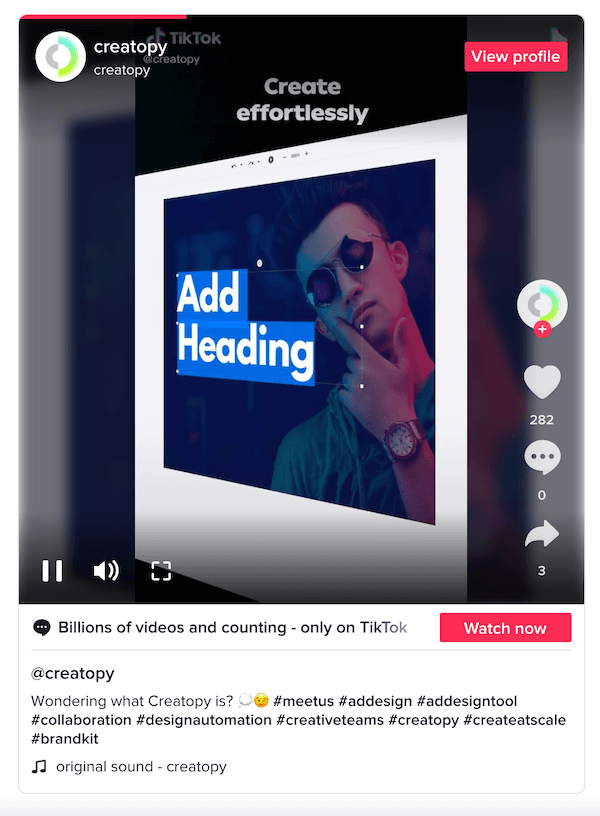Ever since Instagram introduced Reels, the internet has been comparing them to TikTok—and quite brutally. And now that Reels ads are a thing, their rivalry is more palpable than ever. So which ads perform better: TikTok or Reels? Ad design platform Creatopy ran an experiment to let them battle it out. You might be surprised by the results!
TikTok vs Reels ads: The hypothesis
After a lot of internal debate, Creatopy’s PPC team and Social Media Manager hypothesized that TikTok would take home the grand prize due to its high engagement and explosive growth
Both Instagram and TikTok are among the most popular social media platforms and each has one billion monthly active users, but it took TikTok five years to reach this number versus 7.7 years for Instagram.
“Considering TikTok’s success, evolution, and virality, I guessed that the ad would perform better on this platform. And I must mention I’m a big fan of Instagram among all social media platforms,” explained Andreea Mehedin, Creatopy’s Social Media Manager.
Experiment setup
In order to get accurate results from which they could draw clear conclusions, Creatopy kept the variables the same:
- They ran the same 15-second product video on both platforms with the same goal (reach), ad copy, daily budget, total spend, location targeting, etc., for the same time period (September 14 – October 5, 2021).
- They added a custom frequency cap to avoid ad fatigue. After all, the last thing any marketer wants is people getting bored or annoyed by their ads.
- They only used interest targeting (rather than retargeting users who already interacted with ads): users between the ages of 25 and 44 who had expressed interest in education, technology, or apps.

You can see the full setup in the table below:
Note: At the beginning of the experiment, Creatopy’s TikTok account had only about a handful of followers, having been created a few days prior, while its Instagram account already had 5.5k followers (how to get more Instagram followers here). This did not seem to visibly affect the results, but it’s important to note.
The results
Instagram for the win!
Instagram Reels ad outperformed the TikTok ad in all areas:
- Reach and impressions: Instagram Reels reached 389,298 users and received 604,350 impressions while TikTok only reached 199,477 users and received 228,538 impressions. Cost per 1,000 people reached for Reels was also about half that of TikTok at $2.60 vs $5.03.
- Clicks: The Reels ad brought in 38 clicks versus only 28 for TikTok. It’s important to mention that TikTok Ads Manager doesn’t show a distinction between link clicks and ad clicks the way Facebook Ad Manager does, so all clicks on the TikTok ad were counted together.
- Costs: While the CPC and CPM were quite high on both platforms due to the high number of impressions and the low number of clicks, Instagram Reels was still less expensive than TikTok at a CPC of $28.08 vs $35.72 and a CPM of $1.67 vs $4.38. A wider reach at a lower CPC and lower CPM? Yes, please!
- Conversions: There were no conversions on either platform—but this was to be expected. Both campaigns were set up for brand awareness, so conversions were not the main goal.
- Audience:The team also took a look at the list of US states that were most popular as far as impressions are concerned. They found that California, Texas, Florida, and New York were in the top four spots for both platforms. Given that these four are the biggest states in terms of population, the results were to be expected.
You can find the top five states for both platforms in the table below:
Taking all of these into consideration, we can confidently declare Instagram Reels as the winner of this race. This came as a surprise for anyone that was betting on TikTok’s win. It’s clear that even though TikTok has shown impressive and consistent growth, Instagram still has a few tricks up its sleeve. Speaking of which, here are 19 creative Instagram Reels ideas to try out.
Caveats
It’s important to draw some conclusions but not to get too stuck on them. Here are some caveats to consider:
- Age difference: The difference in demographics for these two social media platforms may have contributed to the Instagram Reels ad’s success. The largest age group on TikTok is 18-24 while it’s 25-34 on Instagram, according to Sprout Social. Instagram’s users are aging slowly but surely, according to Debra Aho Williamson, eMarketer principal analyst at Insider Intelligence. So when the team targeted users between the ages of 25 and 44, there was a larger pool of users that they could reach on Instagram.
- Content: It can often be a cross-channel advertising mistake to use the exact same video on every platform. Unless you’re trying to run a certain test, it’s best to study the platforms’ characteristics and audiences and tailor your ads accordingly.
- Every business is different: There is no guarantee that Instagram Reels will win all the time. This experiment declared Reels the winner, but only for this ad and for Creatopy’s audience. A different type of ad, with a different setup, run at a different time frame, could easily bring different results. It’s definitely worth experimenting with your own ads to find out which one is best for your business.
- TikTok did bring results: For a little redemption, it’s worth noting that after running the TikTok ad, Creatopy’s first-ever TikTok video—a more light-hearted post with a human approach that was uploaded shortly before the ad went up—skyrocketed in views, reaching over 100k users.
TikTok vs Instagram Reels ads: experiment observations
If there’s anything we can take away from this experiment, it’s to never underestimate any platform until you try them out for yourself. Whether you’re planning on marketing on TikTok, Instagram Reels, or any other social media platform, always remember to test, test, and test (this is one of our paid media strategy musts!). Have fun and good luck!
You can see Creatopy’s full write-up and infographic of the experiment here.
About the author
Ana Maria Darstaru is Content Marketing Manager by day, avid foodie by night. Passionate about editing content, advertising, human psychology, carbs, and crime-related TV shows.
Source link



